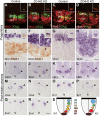ZC4H2 stabilizes RNF220 to pattern ventral spinal cord through modulating Shh/Gli signaling
- PMID: 31336385
- PMCID: PMC7288745
- DOI: 10.1093/jmcb/mjz087
ZC4H2 stabilizes RNF220 to pattern ventral spinal cord through modulating Shh/Gli signaling
Abstract
ZC4H2 encodes a C4H2 type zinc-finger nuclear factor, the mutation of which has been associated with disorders with various clinical phenotypes in human, including developmental delay, intellectual disability and dystonia. ZC4H2 has been suggested to regulate spinal cord patterning in zebrafish as a co-factor for RNF220, an ubiquitin E3 ligase involved in Gli signaling. Here we showed that ZC4H2 and RNF220 knockout animals phenocopy each other in spinal patterning in both mouse and zebrafish, with mispatterned progenitor and neuronal domains in the ventral spinal cord. We showed evidence that ZC4H2 is required for the stability of RNF220 and also proper Gli ubiquitination and signaling in vivo. Our data provides new insights into the possible etiology of the neurodevelopmental impairments observed in ZC4H2-associated syndromes.
Keywords: Gli signaling; RNF220; ZC4H2; patterning; spinal cord.
© The Author(s) (2019). Published by Oxford University Press on behalf of Journal of Molecular Cell Biology, IBCB, SIBS, CAS.
Figures






Similar articles
-
Sequential stabilization of RNF220 by RLIM and ZC4H2 during cerebellum development and Shh-group medulloblastoma progression.J Mol Cell Biol. 2022 Apr 5;14(1):mjab082. doi: 10.1093/jmcb/mjab082. J Mol Cell Biol. 2022. PMID: 35040952 Free PMC article.
-
Loss of ZC4H2 and RNF220 Inhibits Neural Stem Cell Proliferation and Promotes Neuronal Differentiation.Cells. 2020 Jul 1;9(7):1600. doi: 10.3390/cells9071600. Cells. 2020. PMID: 32630355 Free PMC article.
-
Rnf220 cooperates with Zc4h2 to specify spinal progenitor domains.Development. 2018 Sep 3;145(17):dev165340. doi: 10.1242/dev.165340. Development. 2018. PMID: 30177510
-
The many faces of the E3 ubiquitin ligase, RNF220, in neural development and beyond.Dev Growth Differ. 2022 Feb;64(2):98-105. doi: 10.1111/dgd.12756. Epub 2021 Nov 11. Dev Growth Differ. 2022. PMID: 34716995 Review.
-
Gli proteins and the control of spinal-cord patterning.EMBO Rep. 2003 Aug;4(8):761-5. doi: 10.1038/sj.embor.embor896. EMBO Rep. 2003. PMID: 12897799 Free PMC article. Review.
Cited by
-
A Single-Step Genome-Wide Association Study for Semen Traits of Egyptian Buffalo Bulls.Animals (Basel). 2023 Dec 5;13(24):3758. doi: 10.3390/ani13243758. Animals (Basel). 2023. PMID: 38136796 Free PMC article.
-
Sequential stabilization of RNF220 by RLIM and ZC4H2 during cerebellum development and Shh-group medulloblastoma progression.J Mol Cell Biol. 2022 Apr 5;14(1):mjab082. doi: 10.1093/jmcb/mjab082. J Mol Cell Biol. 2022. PMID: 35040952 Free PMC article.
-
Loss of ZC4H2 and RNF220 Inhibits Neural Stem Cell Proliferation and Promotes Neuronal Differentiation.Cells. 2020 Jul 1;9(7):1600. doi: 10.3390/cells9071600. Cells. 2020. PMID: 32630355 Free PMC article.
-
RNF220 is an E3 ubiquitin ligase for AMPA receptors to regulate synaptic transmission.Sci Adv. 2022 Sep 30;8(39):eabq4736. doi: 10.1126/sciadv.abq4736. Epub 2022 Sep 30. Sci Adv. 2022. PMID: 36179027 Free PMC article.
-
N-Terminal deleted isoforms of E3 ligase RNF220 are ubiquitously expressed and required for mouse muscle differentiation.Mol Cells. 2025 Sep;48(9):100250. doi: 10.1016/j.mocell.2025.100250. Epub 2025 Jul 1. Mol Cells. 2025. PMID: 40609864 Free PMC article.
References
-
- Briscoe J., Pierani A., Jessell T.M., et al. (2000). A homeodomain protein code specifies progenitor cell identity and neuronal fate in the ventral neural tube. Cell 101, 435–445. - PubMed
-
- Cheng X.N., Shao M., and Shi D.L. (2018). Mutation of Frizzled8a delays neural retinal cell differentiation and results in microphthalmia in zebrafish. Int. J. Dev. Biol. 62, 285–291. - PubMed
-
- Dessaud E., McMahon A.P., and Briscoe J. (2008). Pattern formation in the vertebrate neural tube: a sonic Hedgehog morphogen-regulated transcriptional network. Development 135, 2489–2503. - PubMed
-
- Jessell T.M. (2000). Neuronal specification in the spinal cord: inductive signals and transcriptional codes. Nat. Rev. Genet. 1, 20–29. - PubMed
Publication types
MeSH terms
Substances
LinkOut - more resources
Full Text Sources
Molecular Biology Databases

